News
Digital health revolution in state hospitals
A silent revolution is taking place ever so quietly not on the streets of Sri Lanka but within its hospitals. How this revolution, using the click of a button, is touching and saving the lives of the humblest of men, women and children and also saving funds for a cash-strapped country was seen at the Castle Street Hospital for Women in Borella just last week.

No queues and quicker processes at the OPD of the Castle Street Hospital for Women, with the doctors ‘armed’ with both stethoscopes and laptops. Pix by Indika Handuwala
One of the numerous ‘beneficiaries’ of this revolution is a tiny three-day-old boy from Badalgama, born prematurely at 32 weeks (usually the gestation period is 38-40 weeks) and transferred to the Castle Street Hospital’s Neonatal Unit, weighing a mere 1.77kg.
Consultant Neonatologist Dr. L.P.C. Saman Kumara has ordered an urgent X-ray, as the baby is having breathing difficulties and we see him looking at the films not on the lit board that is usually stuck on a wall far away from the patients but on a tab, just by the side of the incubator of the baby.
We have seen the radiology staff moving the X-ray equipment close to the incubator, inserting a cassette and taking the X-ray, as we are told that the cassette is being used to convert the X-ray into a digital image.
Earlier the process would have entailed the doctors having to fill a form requesting an X-ray, the technicians coming to the ward, taking the X-ray and returning to the Radiology Department to carry out the chemical processes, drying the film and then requesting collection of it from their department.
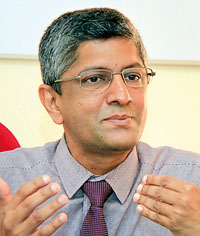
Dr. Praveen De Silva
Precious time – seconds and minutes between life and death. The importance of time is reiterated by Dr. Kumara who says that in the past it took about 30 to 45 minutes for the X-ray process to take place.
“This in an emergency situation spells disaster as these are very urgent X-rays, as a matter of minutes can cost a baby’s life,” he points out, guiding us through mind visualization to the world of the little one, struggling to breathe, with an air-leak affecting his lungs. “Now instantaneously we get the X-rays and we can begin treatment promptly.”
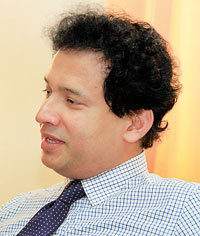
Dr. Nishan Siriwardena
Pointing out that digital X-rays which show the body’s structures 100% accurately are also very useful when doctors have to insert or pull out tubes for treatment, Dr. Kumara adds that the wonder is that the Consultant can also get it sent electronically even when he/she is off-duty and advise juniors in the middle of the night what to do.
It is not only saving a life but in the process also saving time and money, and safeguarding the environment, is how Dr. Kumara puts it in a nutshell. The earlier ‘wet’ process used Silver Nitrate to develop an X-ray, which was costly and harmful to the environment when disposing of the films.
When Dr. Kumara returned after training in the United Kingdom (UK) to take up duties as the first Neonatologist in the country, he was skilled but sad. He had a dream that one day the little ones he was caring for would benefit from the latest technological revolution.
“Now my dream has come true,” he smiles.
We are given an insight into the digital revolution that is passing like the ripple of a wave from hospital to hospital, by three Registrars in Health Informatics, Dr. Praveen De Silva, Dr. Nishan Siriwardena and Dr. Neranga Liyanaarachchi. This is all about ‘Health Informatics’ which is ‘information technology’ being combined with ‘health’, they say, explaining that it is about “innovative ways” to manage health.
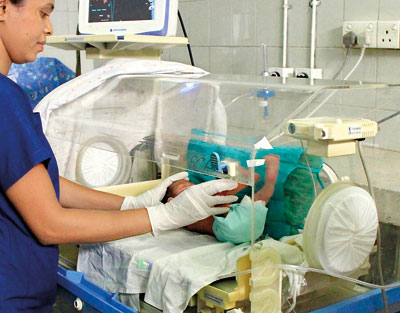 Next we step back into the past and then to the present, with Dr. De Silva pointing out how banks changed their systems in keeping with modern technology but government hospitals remained in a time-warp, with long queues and reams of paper. This was not an experience only in Sri Lanka but worldwide as well. Why? The cost was high as also the failure rate.
Next we step back into the past and then to the present, with Dr. De Silva pointing out how banks changed their systems in keeping with modern technology but government hospitals remained in a time-warp, with long queues and reams of paper. This was not an experience only in Sri Lanka but worldwide as well. Why? The cost was high as also the failure rate.
The crux of the matter was that there was miscommunication between healthcare personnel and information technology (IT) personnel.
The important culture rooted in the health sector could not be understood by the IT people. So they found it difficult to come up with solutions to deliver healthcare, laughs Dr. Siriwardena, adding that while on the part of the health personnel, there was this mindset that “we as doctors and nurses deal with patient care primarily”.
According to them, onto the scene came Prof. Vajira H.W. Dissanayake of the Human Genetics Unit of the Colombo Medical Faculty, whom they dub “a visionary”. He came up with the far-reaching idea of training a set of doctors in health informatics who would be the conduit through which IT could be brought into the health mainstream.
Prof. Dissanayake is the ‘Father of Digital Health’ in Sri Lanka, says Dr. De Silva, explaining that the “starting point” was when he cleared a pathway for doctors to secure an M.Sc in Digital Health at the Postgraduate Institute of Medicine (PGIM) back in 2009. Those armed with this qualification then went into hospitals in 2011.
The next step was for doctors to get a specialist qualification in the field of Health Informatics and that was how the MD programme of the PGIM was launched in 2017, with 38 Registrars in training now.
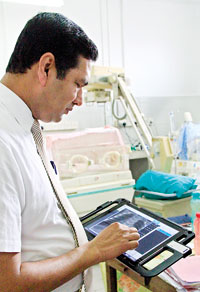
An X-ray of a very ill three-day-old baby in an instant, for Dr. L.P.C. Saman Kumara
With the Health Ministry embracing the concept of digital health being initiated by ‘doctors of the soil’ rather than foreign IT companies introducing it at great cost to Sri Lanka’s already overburdened budget, these are the doctors who are now enabling this silent revolution to blossom in the hospitals across the country.
The hospitals with a vibrant Health Information Management System (HIMS) – a comprehensive electronic system to support functions within these busy hospitals – are the National Cancer Institute (Apeksha), Maharagama; the Castle Street Hospital for Women, Borella; the Lady Ridgeway Hospital (LRH) for Children, Colombo; the Colombo North (Ragama)Teaching Hospital; the Kandy Teaching Hospital; the Peradeniya Teaching Hospital; the Kurunegala Teaching Hospital; the Matale District General Hospital; and the Gampola Base Hospital.
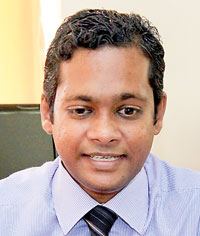
Dr. Neranga Liyanaarachchi
The HIMS started off as “a wild idea” for Dr. Siriwardena who is based at the National Cancer Institute, with Dr. De Silva pointing out that although they were trained in digital health, there was no infrastructure within hospitals, no software training facilities and more importantly no software to suit the country’s health system.
The three of them looked at open-source solutions but found that users’ needs were not addressed. Then this core group of doctors sought technical support from the Kelaniya University by getting in touch with the Head of Department of Industrial Management, Dr. Gamini Wijeratne, discussing technical nuances and work processes for different scenarios.
Parallely, by 2013 they also took a deep look at software needs infrastructure networks, computer server maintenance and training of healthcare staff.
Headway was made when the first-ever Health Informatics and Research Unit was set up at the National Cancer Institute for development and training, with the support of the Sri Lanka Leukaemia Forum, UK. A major achievement, of course, was training support staff not only to use computers but also to be troubleshooters and take on an important role after learning all about networks at the Moratuwa University.
“One of the icons of implementation is the re-skilled hospital staff, empowered with IT knowledge to carry out vital functions minimizing operational cost,” says Dr. Liyanaarachchi, adding that HIMS is a practical example of sustainable and scalable implementation of a complex intervention in the government hospitals.
Within a brief period of time, the rest has become history with the strong support of the Health Ministry top brass including Dr. Champika Wickramasinghe who was then Director of Information and is now Deputy Director-General of Non-Communicable Diseases (NCDs) and all the hospital directors including Dr. Asela Gunawardena, Acting Director of Castle Street Hospital, who embraced this “different” but important system without hesitation.
The proof that the HIMS has benefited all patients while making life smoother for the health staff is obvious as we walk around the Castle Street Hospital. Expectant mothers walk in and submit their details at the counter if it is their first visit and then are issued a card with a Personal Health Number. Thereafter, they are in the HIMS. They can even indicate whether they are happy with the service or not by pressing a row of smiley and sad faces on a tab on the counter.
| What is HIMS? Delivering patient-centred care through eHealth innovations is the major achievement of the Health Information Management System (HIMS). HIMS is being implemented in full scale as an admission, discharge and transfer module, with the outpatient (OPD) module, pharmacy module, laboratory module and radiology modules being fully integrated, says Dr. Neranga Liyanaarachchi, adding that the financial icon of the systems is the upfront saving of millions of rupees by integrating open source PACS (Picture, Archiving and Communication System) and digitalizing medical images without procuring expensive software solutions.This digitalization cuts down the image printing costs and reduces undue delays in urgent image requests. HIMS was also successful in linking to commonly used laboratory analysers, hence cutting down a significant proportion of hours spent on investigation and delivery of reports to the wards, he points out. Meanwhile, the HIMS augmented hospital dashboard has also been developed with the assistance of the Bloomberg Data for Health Initiative. It is capable of showing a high-level summary of clinical and non-clinical information vital for managerial decisions, it is learnt. And the vision for the future is: | |

